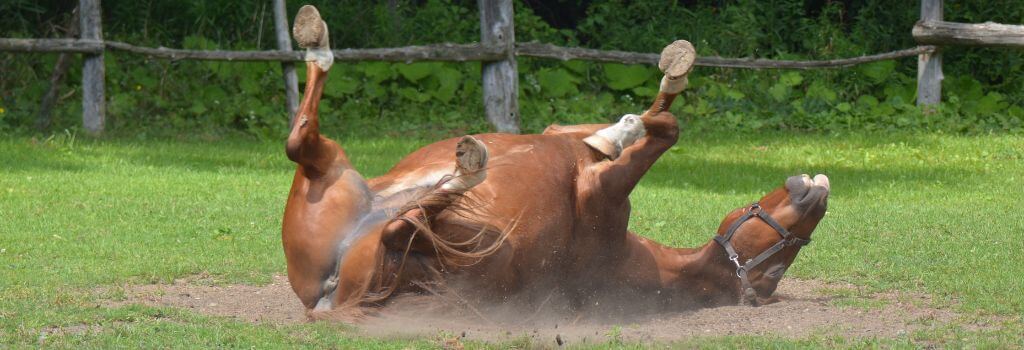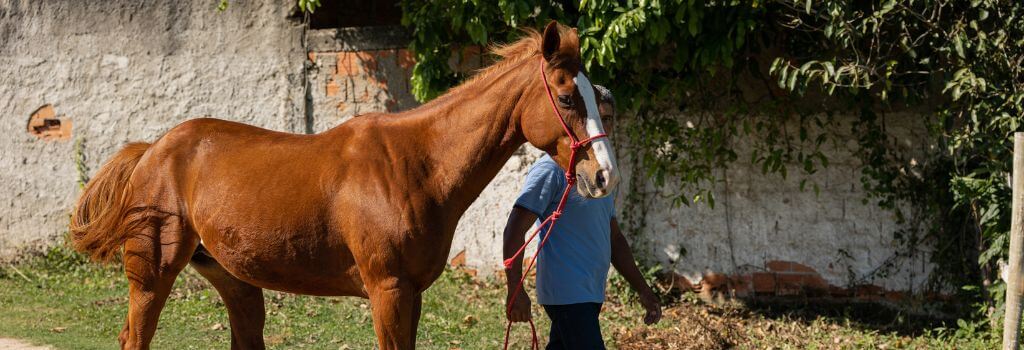Colic is one of the most common equine emergencies and a leading cause of death in horses. This abdominal pain can range from mild discomfort to a severe, life-threatening condition. One of the most challenging aspects of colic in horses is that the signs don’t always reflect the seriousness of the situation, making early recognition and prompt veterinary care absolutely critical.
In this blog, we’ll walk through the common signs of colic in horses, the possible causes behind it, and the treatment options available.
What is Colic in Horses?
Colic is a general term for abdominal pain, but for horses, it can be much more serious than just a simple stomach ache. Unlike humans, horses can’t vomit, and their long, complex digestive systems make them more susceptible to twists, blockages, and painful gas buildup. This is why colic is a significant concern, and it’s so important to recognize the signs early. What might begin as mild discomfort can quickly escalate into a life-threatening emergency!
What Causes Colic in Horses?
Often, the cause of colic is unknown, and unfortunately, it is often just a matter of bad luck when your horse experiences colic. However, some types of colic, such as impactions, typically have a known cause. Let’s talk about a few common causes.
Common Causes of Colic in Horses
- Impaction (Constipation in Horses): When a horse doesn’t drink enough water, eats poor-quality hay, or struggles to chew properly, food can get stuck in the intestines, leading to a blockage.
- Gas Colic: A buildup of gas in the intestines can cause discomfort but is can be treatable with medication.
- Twisted Gut (Large Colon Volvulus or Small Intestinal Strangulating Lipoma): A severe and life-threatening type of colic that requires emergency surgery.
- Sand Colic: This happens when horses ingest sand while eating, leading to irritation and blockage.
- Dietary Changes: Sudden changes in feed or hay can disrupt digestion and cause colic.
Unfortunately, some of the most dangerous types of colic—like a twisted intestine—have no known prevention and require immediate medical or surgical intervention.

Recognizing the Symptoms of Colic in Horses
There are a large variety of symptoms that could indicate colic. It could be anything from not wanting to eat or frequently laying down to rolling, pawing, and flank-watching. We often receive calls about horses that are stretching out to pee but not peeing. This is also a common presentation for colic in horses. All these actions (or non-actions) are different ways a horse tries to tell you that its abdomen hurts!
Symptoms of Colic in Horses:
- Loss of appetite
- Frequent lying down
- Rolling or pawing
- Flank-watching
- Passing dry or mucus-covered manure
- Fecal balls smaller than usual
- Change in drinking behavior
- Stretching out to urinate but not peeing
It’s important to remember that symptoms don’t always match the severity of the problem. A horse with mild signs such as refusing food or quietly lying down could have something serious like a twisted part of their intestine. On the other hand, some horses with gas colic (essentially a painful gas buildup, sometimes called "a fart stuck sideways") can act extremely uncomfortable but recover quickly with the right treatment. Without having your veterinarian do some diagnostic tests, it is difficult to determine how serious the problem is.
Colic Treatment in Horses
Colic treatment in horses depends on what’s causing the issue and how severe it is.
Step 1: Pain Relief with Medication
One of the first lines of treatment is Banamine (flunixin meglumine), a non-steroidal anti-inflammatory medication that helps relieve abdominal pain. Many horse owners refer to all versions of this drug as Banamine, but some products may be labeled under a different brand name.
In addition to Banamine, there is a medication called Buscopan that helps relax the gastrointestinal tract or reduce cramping in the guts. This medication only lasts about 30 minutes, so in some cases, a horse may feel better for that period of time but then become uncomfortable again once the medication wears off.
Step 2: Fluid Therapy for Impaction and Dehydration
There are situations in which the above medications may not fix the colic. In these cases, more aggressive medical therapy is usually recommended by your veterinarian. This means fluids, fluids, and more fluids! The goal with fluids is to rehydrate the horse and saturate the gastrointestinal contents to hopefully get things to move through. Horses are big animals, so fluid therapy usually requires a lot of fluids. For example, a horse might receive up to 60 liters of intravenous fluids in a day, sometimes more! That’s almost 16 gallons!
Fluids can be given in three ways:
- Nasogastric Tube: Fluids are given directly into the stomach to correct dehydration and soften an impaction.
- Intravenous (IV) Fluids: Used for severely dehydrated horses.
- Fluids Per Rectum: Helps correct dehydration and soften an impaction.
Step 3: Surgery for Severe Cases
If a horse continues to show signs of colic despite aggressive medical therapy, surgery is often recommended. There are also some scenarios in which a horse is so uncomfortable that surgery is recommended right away. Surgery is needed in cases when there is a concern for a twisted gut or a severe blockage. These things cannot be fixed with fluid therapy alone and time is of the essence if a piece of intestine is twisted and possibly losing blood flow.
Signs that your horse may need surgery:
- Severe, persistent pain that doesn’t improve with medication.
- A distended (bloated) abdomen.
- Signs of shock, such as cold limbs, rapid heart rate, or extreme lethargy.
- Discomfort that may be mild but prolonged (days).

When to Call Your Veterinarian
The safest and most cautious option is to have your veterinarian evaluate your horse right at the onset of signs of colic. However, it is fair to administer a dose of Banamine (as prescribed by your veterinarian) and monitor the horse closely. Here’s when to seek immediate veterinary care:
- Banamine doesn’t work or symptoms return after it wears off.
- Symptoms worsen, or your horse is in severe distress.
- Your horse refuses food and water for an extended period.
Understanding what to look for, spotting the signs, and knowing when to reach out to your veterinary team can make a world of difference for horse owners. Keep in mind that colic can be unpredictable, so making quick decisions is really important. The most valuable thing you can do is stay informed, trust your instincts, and collaborate closely with your veterinarian to give your horse the best chance at a full recovery.
A well-prepared horse owner isn’t just reacting to emergencies—they’re taking steps every day to support their horse’s digestive health, reducing the risk of colic before it starts. So, keep an eye on your horse, follow good management practices, and remember that you’re their best advocate!
If you have questions and you'd like to reach out to us, you can call us directly at (970) 987-4757, or you can email us at [email protected]. Don't forget to follow us on social media Facebook, Instagram.
